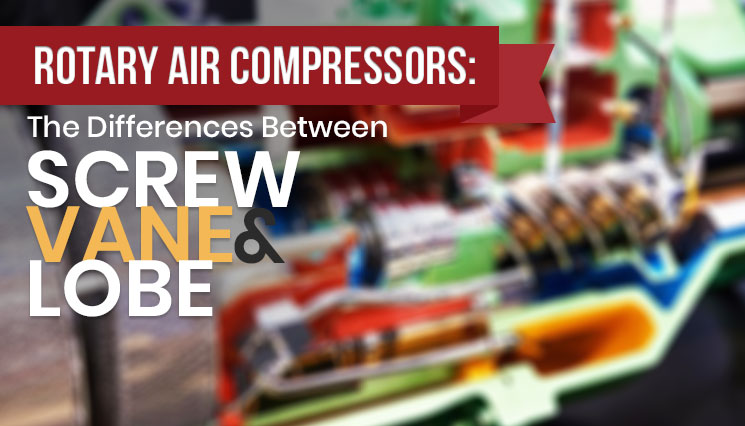An air compressor is a machine that pressurizes air in order to supply power to a number of air-powered tools. It is only among the many – if not countless – uses of the device that makes it an essential device in various industries.
There are two common types of air compressors:
Positive-displacement – a common type of air compressor ideal for both small-scale and industrial-scale applications; and
Piston-type – a type of compressor that uses a piston and crankshaft to introduce and store air into a chamber.
In this article, we focused on an air compressor model that falls under the positive-displacement category: rotary air compressor. Alongside it are its three common types including lobe, screw and vane.
What is a Rotary Air Compressor?
Instead of a piston and a crankshaft similar to that of piston-type air compressors, their counterpart, rotary air compressors have two asymmetrical rotors that rotate and compress the air.
A rotary air compressor works by pulling in air and trapping them between the rotors before it is transferred to the other side of the rotors. Compression is completed when the air is trapped in clearance between the rotors then pushed towards the pressure side.
Types of Rotary Air Compressor
- Screw Air Compressor – this type of air compressor is arguably the most widely used model today. It proves to be efficient in terms of air pressure requirements and energy consumption, having the ability to deliver continuous air in an efficient and quiet operation. It is available in two types including oil-injected and oil-free.
- Advantages: Quiet operation | Continuous air supply | Low energy consumption | Low air pressure requirements
- Disadvantages: Slightly expensive | Complex in design | High maintenance | Recovery time requirement
- Vane Air Compressor – another type of rotary compressor, a vane model has a fixed casing in which a rotor is placed to hold the sliding plates. Every time the plates slide away from the center, air gets trapped and compressed into a chamber.
- Advantages: Easy maintenance | Simple in design
- Lobe Air Compressor – probably the most straightforward type of rotary compressor, a lobe model is recognized for the absence of complicated parts. It only has two lobes attached to a shaft and driven by a prime mover. The air gets trapped in between the lobes and as they rotate, air gets compressed and delivered.
- Advantages: Simple in design | Easy operation
Aside from these three common types of rotary air compressor, there is another model that should not be missed: scroll air compressor.
- Scroll Air Compressor – a scroll compressor is considered the best type in the field. It consists of two spirals, one stationary and one movable. It works by trapping air inside the spiral and transport it in small air-pockets toward the center of the spiral. It takes a minimum of 2 turns before the air reaches the pressure output in the center.
- Advantages: Quiet operation | Compact in size | Simple in design | Low maintenance | Oil-free
- Disadvantages: Low output capacity | Relatively expensive | High temperature
Your Best Bets on Rotary Air Compressor
Ingersoll Rand Screw Compressor
- Oil-free and oil-flooded rotary screw
- 4-375kw (5-500Hp) air-cooled or water-cooled
- Fixed speed or variable speed drives
- 2-stage & single-stage compression module & rotors
- Easy system monitoring
Armstrong Scroll Compressor
- Industrial scroll air compressors
- 5.5-22kw (7.5-30Hp) energy efficient
- Quiet operation
- Patents integrated in one design
FS Curtis Screw Compressor
- Oil-free and oil-lubricated rotary screw
- 5.5-400kw (7.5-500Hp) air-cooled or water-cooled
- Fixed speed or variable speed drives
- High performance
- User-friendly monitoring & control
These rotary air compressors are further categorized based on capacity, horsepower, voltage and configuration. Discover the many types of air compressor here at Compresstech and decide for the rotary air compressor that matches your every need.
Did you find this article informative? Let us know by commenting below!

